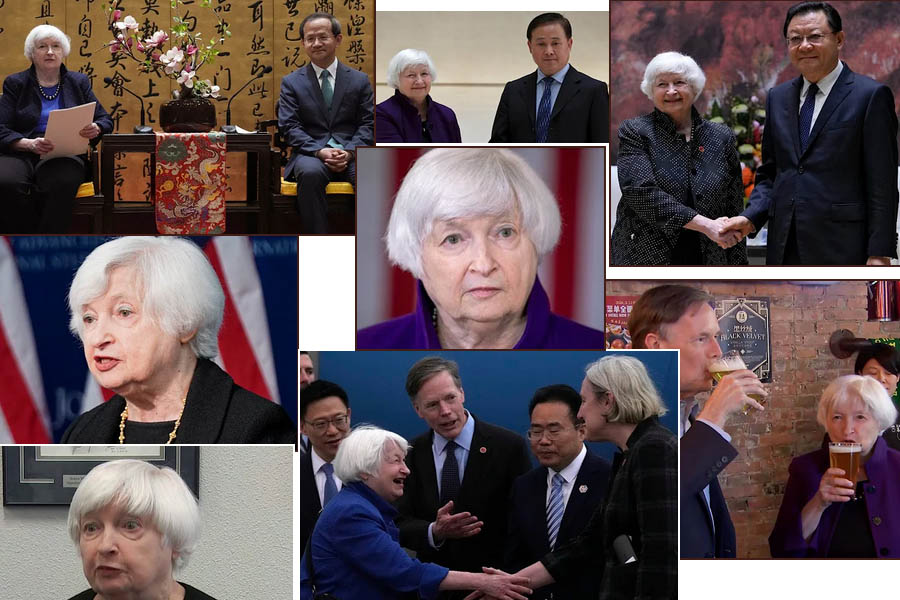
The recent visit of US Treasury Secretary Janet Yellen to China has brought to the forefront the simmering tensions between the two economic giants. Yellen's call for China to reassess its economic growth strategy met with resistance, reflecting the deep ideological divide in their approaches to economic policy.
Yellen criticized China's interventionist measures aimed at supporting specific industries, cautioning against the risks posed to American and global workers. However, Beijing remains committed to bolstering its manufacturing sector, a stance that could exacerbate existing trade imbalances.
The failure of Yellen's pleas for reflation highlights the complexities in US-China relations. China's reluctance to heed Washington's advice echoes Japan's struggle with economic stagnation despite extensive fiscal and monetary stimulus. Without substantive structural reforms, China risks mirroring Japan's trajectory towards debt-fueled growth with diminishing returns.
Amidst these tensions, prospects for resolution appear dim. Washington's insistence on fair economic practices clashes with Beijing's agenda of prioritizing domestic industries and technological innovation, raising the specter of further escalation that could destabilize the global economy.
Optimist Perspective:
Despite the challenges, there are glimmers of hope in US-China relations. China's innovative monetary policies, exemplified by the People’s Bank of China's relending scheme, underscore its commitment to fostering technological innovation and sustainable growth.
The PBOC's initiative to provide credit to small-and-midsize tech companies reflects China's transition towards a more market-oriented economy. By targeting sectors pivotal for future growth, such as science and technology, China aims to boost productivity and facilitate structural transformation.
Moreover, China's emphasis on quality growth aligns with President Xi Jinping's vision of modernizing the industrial system and propelling the development of new productive forces. Initiatives like "Made in China 2025" underscore China's determination to lead the global charge in high-tech industries.
Prioritizing tech-driven growth not only enhances China's competitiveness but also fosters global innovation and collaboration. By investing in human capital and nurturing emerging industries, China lays the groundwork for sustainable economic development.
In conclusion, while tensions persist, avenues for cooperation and mutual benefit exist between the US and China. Embracing innovation and embracing inclusive growth strategies can enable both nations to navigate the complexities of the modern world and chart a course towards shared prosperity.
China's Economic Strategy: Learning from Japan's Mistakes
The People’s Bank of China (PBOC) has unveiled a groundbreaking initiative aimed at supporting innovation in science and technology. This initiative, announced during US Treasury Secretary Janet Yellen’s recent visit to Beijing, underscores China's commitment to driving economic growth through technological advancement.
The program, known as a "relending" scheme, will provide up to 500 billion yuan (approximately US$69 billion) in credit to select institutions. These funds will be directed towards targeted sectors in need of monetary support, particularly small-and-midsize tech companies. With an interest rate of 1.75%, these loans aim to fuel innovation and propel China's transformation into a high-tech powerhouse.
This initiative comes at a critical juncture as China faces economic challenges and pressures from international economists. While some experts advocate for aggressive monetary policies akin to those pursued by Japan in the 1990s, China appears to favor a different approach.
Rather than relying solely on fiscal and monetary stimulus, China is pursuing a strategy of hyper-targeted liquidity infusions coupled with structural reforms. This approach aims to shift growth engines towards tech-driven future industries, thereby enhancing disruption and productivity. By prioritizing innovation and technological advancement, China seeks to address long-term economic challenges and foster sustainable growth.
The PBOC's lending program is just one facet of China's broader policy mix for 2024, which includes efforts to revamp housing credit policies, bolster demand, and support distressed property developers. Moreover, Chinese officials are exploring new mechanisms to increase efficiency in the real economy and promote innovation and productivity.
However, critics, including Yellen, have voiced concerns about China's economic practices and called for a level playing field for American workers and firms. Yellen's plea for China to ramp up stimulus efforts reflects the urgency in addressing global economic imbalances.
Yet, China must proceed cautiously and learn from Japan's experience. Japan's prolonged pursuit of fiscal and monetary stimulus without bold supply-side reforms led to mediocre success and mounting debt burdens. China must avoid falling into a similar trap of economic mediocrity.
Instead, China is focused on modernizing its industrial system and accelerating the development of new productive forces. Efforts to champion high-tech industries, such as semiconductors, biotechnology, and artificial intelligence, are central to China's "Made in China 2025" project.
By investing in future-oriented sectors and prioritizing innovation, China aims to drive sustainable economic growth and enhance its global competitiveness. The PBOC's lending program represents a step towards realizing this vision, but China's success will hinge on its ability to implement effective structural reforms and foster an environment conducive to innovation and entrepreneurship.
Thank you for reading: globalpostheadline.com | If you want to advertise your Company, Events, Movies, Products, Hotels, Travel Packages Let us know